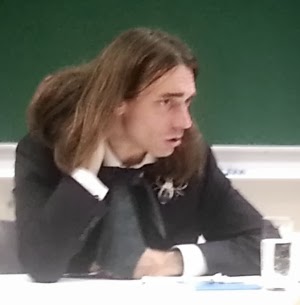Interview with Cédric Villani
BLOG: Heidelberg Laureate Forum

Cédric Villani had a small press conference at the Heidelberg Laureate Forum. Most of the reporters present were not mathematicians and did not ask technical questions. They seemed to view Villani as a sort of specimen of an alien species, asking sincere but naive questions about what it is like to be a mathematician. I wanted to go a little more technical than that.
I started my career in the same general area as Villani, nonlinear partial differential equations (PDEs), and I wondered whether he had experienced some of the disorientation I felt at times. I sometimes felt so lost in the abstractions built to study PDEs that I lost sight of the PDEs themselves. Also, I was curious whether Villani used much computation in his work — either numerical solution of PDEs or software for symbolic calculation — or whether he primarily did pencil-and-paper math.
Cook: Do you ever feel like you get lost in Sobolev spaces, functional analysis, etc. and loose site of the differential equations? An along with that, do you use numeric or symbolic computation, or do you mostly do pencil-and-paper math?

Villani: First of all, you mention function spaces. More generally one can say formalism, abstraction. Of course, mathematics is by definition abstraction. Now there is the whole issue of knowing whether you are using the abstract tools to support your idea, or if you guided by them, maybe misguided by them. You could end up in some bad direction because the abstract tools can lead you there. Often it is in between.
With respect to other mathematicians, I believe I give less importance to functional spaces and abstract tools and more to the general stream of ideas. I’ve worked in extremely different contexts. For example, when I was working on one project I was working in metric spaces, almost no structure, no differentiability. By contrast, when I was working on another project, it was infinitely smooth, even analytic, total rigidity. It’s rather rare to go between such extremes. Just by thinking about it I would end up working with this or that structure.
I often think a good proof of a theorem in mathematical physics should reflect the real physical reason something occurs, and mathematical formalism is only there to flesh out these ideas.
Now about numerical simulations, I use them for intuition rather often. I never do them myself. I have other people do them. I think this is more efficient and quicker. The simulations can be very useful.
Pencil and paper is very natural. There is the connection from the brain to the hand. These days we still know how to write. Maybe some day this will disappear.
***
Notice in the photo of Villani above that he is wearing a spider broach. I had heard that he always wears one. I asked him about this and whether there was a story behind the spiders. He only answered “maybe” to the question of whether there was a story behind the spiders. But he said it is true that he always wears one and that he as a collection of around 20 of them. He then brought out several to show us and indicated that several of the spider broaches had been custom made for him.

